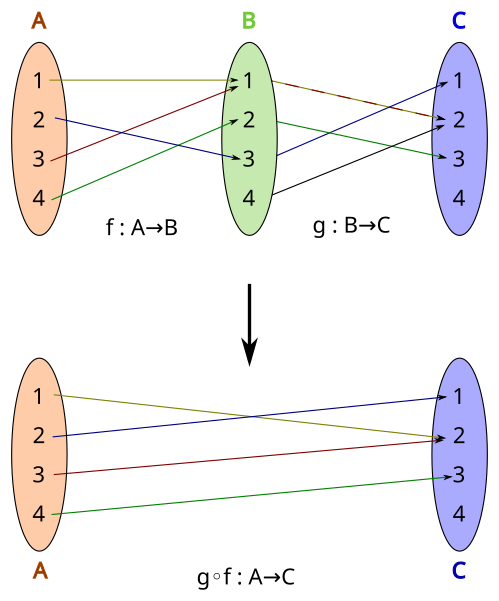An algebra of functions
For this section, suppose that and are functions.
Definition (Composition).
The composition of and is the function given by .

Exercises.
Prove that the composition of injective (surjective) functions is again injective (surjective).
Assume that is injective (surjective). What can you say about the injectivity (surjectivity) of and ?
If is bijective, the inverse of is the function from to . Why is bijectivity, that is the fact that be both injective and surjective, important here?
Definition (Restriction).
The restriction of to is the function defined by .
Examples.
- The restriction of a constant function is constant.
- The restriction of an injective function is injective.
- The restriction of the identity on a set to any subset of is the identity on that subset.
Notation.
The set of all functions is denoted by . This choice of symbol is motivated in the tutorials, where it is shown that for finite sets .
Equinumerosity
To measure is to compare.
Notation.
I abbreviate the phrase “there exists a bijective function ” by writing . I will also say and are equinumerous, or have the same size.
This symbol has the following properties, which you should verify yourself.
Proposition.
For any set ,
- (Reflexivity).
- If , then (Symmetry).
- If and , then (Transitivity).
Compare these properties with others mentioned in previous chapters, such as here.
Metamathematical warning (safe to ignore):
Despite appearances, it is not correct to say that this symbol defines an equivalence relation. An explanation for this goes well beyond the scope of this course.
For the sake of intuition, you can think of cardinal numbers as precisely the equivalence classes of this relation.
Finite sets revisited
Earlier I defined the word finite in terms of natural numbers. Indeed, a way to rewrite my earlier definition is that a set is finite if there is a natural such that . In this case, it is shorter to just write , but I must first convince you that this is well-defined.
Reflect.
Well-defined, in this instance, means that there could be more than one natural satisfying the definition. How do you know which one to pick? Of course this does not happen, but I must prove this to you.
It wasn’t until 1888 that Dedekind came up with a definition of finite set that did not need the naturals to be constructed first. I will not use the definition, but if you are curious, one can prove that a set is finite if and only if it is not equinumerous with a proper subset of itself. This can be used to define finiteness without reference to any numbers. The fact that is infinite in this context is known as Galileo’s paradox.
A subset of a set is called a proper subset, denoted if but .
Lemma.
For every natural , there is no bijection from to a proper subset of it.
Proof:
By induction on .
The base case is vacuously true. Suppose that and let and .
By contrapositive, suppose that is a bijection. If , then is a bijection onto . But the domain has size , so by the inductive hypothesis, .
If, on the other hand, , then define by the rule
is a bijection, so by inductive hypothesis, . Adding the element to both sets, I get the sought equality.
Corollary.
- If and are two naturals witnessing the finiteness of the same set , then .
- is infinite.
This really is the classic children’s game “my number is your number plus one.”
Proof of 2:
By contradiction, suppose that is a bijection. Obviously ; then the function is a bijection onto its image. The number belongs to the domain but not the image and thus contradicts the lemma.
Exercise.
Prove that the set of prime numbers is an infinite subset of .
Hint.
Let be a finite collection of primes, then notice that and are relative primes. Conclude using FTA that no finite set of primes contains all primes.
I can finally formalize the idea that finite plus finite is finite:
Theorem.
The union of finite sets is finite.
Other than the union, what other operations on sets preserve finiteness?
Theorem.
The powerset of a finite set is finite. Moreover, it has size .
Proofs in tutorials.
Hard exercise.
Prove from the definition that a subset of a finite set is finite.